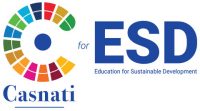Casnati for ESD promotes Sustainable Development.
What are the main objectives of the Casnati for ESD?
- To train students (and even before teachers) to be prepared and sensitive to the “concept” of Sustainable Development and ESD so that they become educators and promoters of a more eco-sustainable way of life.
- To increase the general audience’s sensitivity to ESD/ SD.
What does the integration of Education for Sustainable Development (ESD) mean for CSC students?
First of all, for CSC Students the didactic integration of ESD means :
- Developing, in addition to the transversal skills outlined at the Italian ministerial level, also the transversal soft skills defined by UNESCO
- systems thinking competency
- anticipatory competency
- regulatory competency (with reference to reflective pedagogy)
- strategic competency
- collaborative competency
- critical thinking competency
- integrative problem-solving competency
- self-awareness competency
Each of these soft skills finds a specific declination within each disciplinary area.
- During the course of Secondary School, thanks to the contribution of each disciplinary area to the construction of the Civics path, achieve the UNESCO learning objectives for each SDG.
- Particular attention and awareness of the three levels of learning: 1 – cognitive (knowing how to understand), 2 – socio-emotional (knowing how to feel), 3 – development of skills (knowing how to do) with the integration of the methodological principles of Socio-Emotional Learning (SEL).
Education for Sustainable Development (ESD) is defined as education that empowers learners to take informed decisions and responsible actions for environmental integrity, economic viability and a just society for present and future generations.
UNESCO
The strategies of active learning, already wisely adopted by the CSC through the many years of experience as a Cambridge International School, are the natural terrain on which to integrate the ESD.
The resulting positive effects on the lives of students are widely documented by academic results of international relevance.
- Improvement of university outcomes (A Stanford University review found that curricular integration of environmental education improves academic performance through improved critical thinking and transversal skill development).
- Better mnemonic-cognitive performance thanks to didactic activities in green spaces.
- Greater consolidation of transversal soft skills.
- A better and enriched understanding of the complex system underlying sustainable development.
- Increased involvement and motivation.
- Improvement of physical and mental health.
- Increased propensity for peaceful social life.
- Increased civic aptitude with better ability in terms of self-information and self-management of emotions.

To Learn More:
- Sandford Analysis Reveals Wide Array of Benefits from Environmental Education https://naaee.org/sites/default/files/eepro/resource/files/ k-12_student_key_findings_0.pdf
- Aikens, Kathleen. Draft Report, Impacts of Education 2030 on Key Performance Indicators, 2020
- Education for people and planet: creating sustainable futures for all, Global education monitoring report, 2016
- Louise Chawla, Kelly Keena, Illène Pevec, Emily Stanley, Green schoolyards as havens from stress and resources for resilience in childhood and adolescence, Health & Place, Volume 28, 2014, Pages 1-13, ISSN 1353-8292, https://doi.org/10.1016/ j.healthplace.2014.03.001.
- Laurie R, Nonoyama-Tarumi Y, Mckeown R, Hopkins C. Contributions of Education for Sustainable Development (ESD) to Quality Education: A Synthesis of Research. Journal of Education for Sustainable Development. 2016;10(2):226-242. doi:10.1177/0973408216661442
